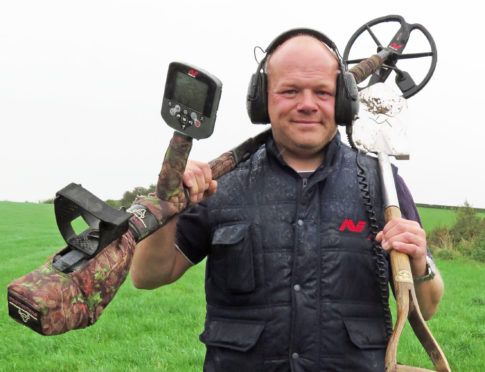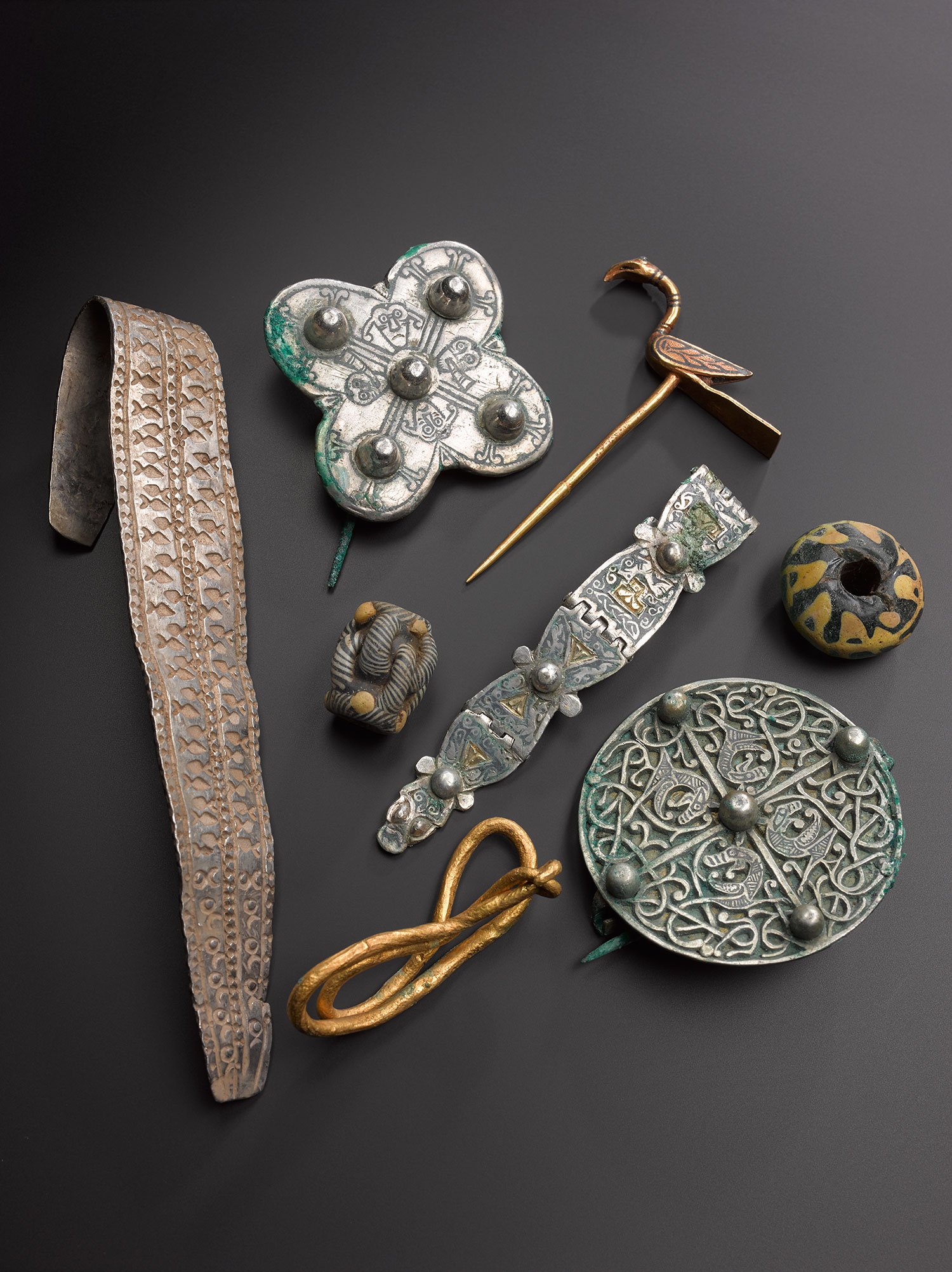
A metal detector enthusiast who unearthed Britain’s richest haul of Viking treasure is being sued by the Church of Scotland for a share of the spoils.
Derek McLennan, from Ayrshire, found more than 100 objects, including solid gold jewellery, on church land in Dumfries and Galloway in September 2014.
The items, thought to have been buried in the 10th Century, included an early Christian cross made of solid silver, with distinctive enamelled decorations.
National Museums Scotland raised almost £2 million to acquire the treasures – now called the Galloway Hoard – from the Crown Estate, with the finder, Mr McLennan, to receive the money.
At the time, it was reported he would share any proceeds with the Kirk. But now church trustees have launched an action at the Court of Session in Edinburgh to recover what they claim is due to them.
Last week, Mr McLennan’s friend and fellow metal detector enthusiast, the Rev David Bartholomew, who was with him when he made his discovery, told how the euphoria when the first artefact was pulled from the ground turned to acrimony.
The Castle Douglas minister said: “Derek was my friend and it is sad that it has come to this.
“It is my understanding there was always an agreement the money would be shared with the Church.
“I’m surprised Derek would go back on a deal because he had done everything by the book at all times. I don’t understand why he would, it is not a thing that can be avoided.
“There is an unwritten rule among metal detectorists that you split any find with the landowner, otherwise they might not give permission to search on their ground.”
Mr McLennan had searched the unidentified area of Church of Scotland land for more than a year in the hunt for treasure.
Mr Bartholomew and another keen detectorist friend, Mike Smith, the pastor of an Elim Pentecostal Church in Galloway, were with him when the discovery was made.
Mr McLennan, 50, unearthed the valuables two feet beneath the ground – well below the depth his machine should pick up a signal.
There was great excitement when Mr McLennan then waved aloft an ancient silver arm ring and shouted: “Viking!”
The haul was described as “outstanding and exceptional” by experts, and included a rare gold ingot, beads, crystals and a decorated silver-gilt cup thought to be of Byzantine origin.
Mr Bartholomew said: “I would never have found the hoard. Derek did because he is a gifted detectorist.
“I was just pleased to be part of an amazing day.”
Mr McLennan passed on the treasure to the Queen’s and Lord Treasurer’s Remembrancer, which rules on found goods and property without an owner.
Unlike the rest of the UK, where the awards are split between the finder and the landowner, in Scotland rules on discoveries allow the finder to keep the full amount.
In Scotland, it is at the discretion of the metal detectorist if payments are made to the landowner.
When the discovery was made, the Kirk said its General Trustees, as the landowners, had reached agreement with Mr McLennan about sharing any proceeds – and any money would “first and foremost be used for the good of the local parish”.
Two years ago, it was announced National Museums Scotland had raised £1.98m to pay the finder for the Viking haul.
The Kirk said at the time: “The Church has worked closely with the finder and agreed an equitable share of its value.”
However, news of the impending legal action suggests that no agreeable split has materialised.
Mr Bartholomew said that last autumn the Kirk asked him to approach Mr McLennan about the matter as officials had struggled to make contact with him.
“The Church knew I was Derek’s friend and I was with him at the time of the find so I phoned, emailed and wrote to him but I never heard anything back.
“I even went to visit him at his house but I could never get him at home, so I was asked to give a statement to the Church about it.”
He added: “It is my understanding the Church did not want to go through the courts as it does no one any good.”
Following the find, Mr McLennan and his detectorist wife Sharon launched a firm called Beyond The Beep, to work with the Coming Home Centre for ex-forces personnel in Glasgow and veterans’ mental health charity Combat Stress.
A Church of Scotland spokesperson last night said: “It can be confirmed the General Trustees of the Church of Scotland have raised an action against Derek McLennan. As that is now a matter before the court it would be inappropriate for us to provide any further commentary at this time.”
The Galloway Hoard will be displayed at the National Museum of Scotland in Edinburgh from May to November next year before visiting Kirkcudbright, Dundee and Aberdeen.
Mr McLennan did not respond to our requests for a comment.
When I saw what it was, I couldn’t even speak.
Derek McLennan found the Viking treasure just months after discovering hundreds of medieval coins in Twynholm, Kirkcudbrightshire, in another landmark find.
He only started using a metal detector a few years before two stunning discoveries.
Speaking to The Sunday Post in 2014, he described the moment he literally struck gold on the Church of Scotland land, which was deliberately not identified.
He said: “When I realised what I’d found I couldn’t even speak. I was in complete shock.
“We started at 10am and just over an hour later, I made the discovery.
“The detector made a signal I should never have heard because the find was so deep. I started to dig but I thought it would just be a cast-iron pipe.
“When I put my hand in the hole I felt what I thought was a heavy silver spoon, but when I rubbed it with my thumb and saw the
criss-cross design I realised it was Viking.
“I knew it was significant. I had to contact the Treasure Trove Unit so they could get archaeologists there as soon as possible. I ran to the car for my phone, but I hardly had any battery left, so I called my partner Sharon to get her to phone the unit.
“I was so emotional, I was incoherent. Sharon thought I’d crashed the car. Eventually I calmed down a little and explained what I’d found.”
Archaeologists from Historic Scotland arrived within a few hours and began a meticulous excavation.
Nothing like the Galloway Hoard has ever been found before in Scotland.
The buried Viking treasure haul discovered by Derek McLennan was hailed as one of the most important archeological finds in Scotland.
The trove, now called the Galloway Hoard, comprised more than 100 artefacts, including a spectacular Viking Age collection of silver jewellery and gold.
It contains an unparalleled range of precious metal and jewelled items, including a rare gold ingot, a unique gold bird-shaped pin and a decorated silver-gilt vessel.
“Nothing like this has ever been found before in Scotland,” said Dr Martin Goldberg, a leading historian at National Museums Scotland, which purchased the treasure for the nation.
“We like to think of objects as having lives and our research will trace the stories of the objects back to when and where they were made, as well as why they were buried at that time and in that place.
“That range of stories will expand our knowledge of the Viking Age.”
The find also marks an important moment in history – the formation of the political entities we now know as Scotland, England and Ireland.
At the start of the 10th Century, Alfred the Great had pushed back the Danes and his descendants had begun to lay the foundations of medieval England.
Meanwhile, in the north, Alba – the foundation of medieval Scotland – was forming.
With its central location within the British Isles, Galloway was at the centre of these political developments and had close connections to Ireland.
The Vikings were feared across the world for their raiding and brutal colonising of other lands. In the Viking Age – roughly 793-1066 – the islands in the west of Scotland made perfect base camps for armies to gather and trading posts to spring up.
By the early 9th Century, Vikings had taken enough territory in Scotland to form their own kingdom here – called Lothlend, or Lochlainn – which at its height extended influence from Dublin to York.
This Scandinavian presence helped forge many fragmented Scots tribes into one people.

Enjoy the convenience of having The Sunday Post delivered as a digital ePaper straight to your smartphone, tablet or computer.
Subscribe for only £5.49 a month and enjoy all the benefits of the printed paper as a digital replica.
Subscribe